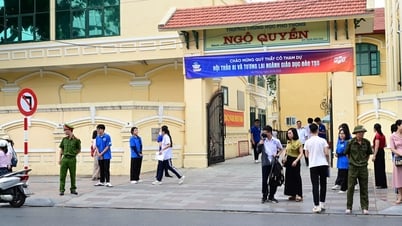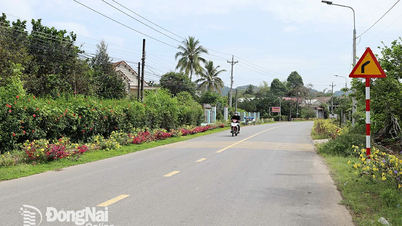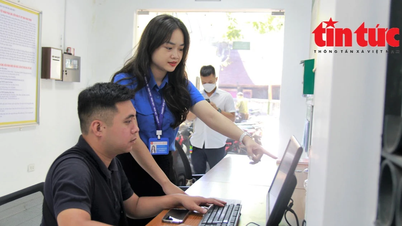Free dental check-up for students in Da Lat City |
From 2019 to present, the work of protecting and taking care of children's and students' health in schools in the province has always received attention and close direction from all levels and sectors from the province to the locality such as: allocating local funding for the program of activities, directing schools to coordinate with the health sector to implement activities in schools conveniently and with the support of the school. The whole province currently has 669 schools from kindergarten to high school, all of which have been invested in some equipment and a basic list of medicines to serve the work of health care. Healtheducation and communication work is flexibly organized by schools in many forms...
The Health and Education sectors regularly coordinate to direct schools to organize propaganda sessions and talks on health education; regularly inspect health care work; organize many health care programs for students. Health units do a good job of primary health care, disease prevention and control for students at school. Maintain safe school construction, integrate health care activities in schools such as: expanded vaccination, improving student nutrition, disease prevention and control... Guide, direct, support and inspect, evaluate schools on the conditions of facilities to ensure school hygiene, guide the work of disease prevention and control and school diseases, food safety, nutrition in schools. Disease prevention and control in schools is implemented, contributing to gradually reducing the rate of refractive errors, scoliosis, oral diseases, worms... and health risk factors in schools.
District and city health centers proactively coordinate with the Department of Education and Training in developing inter-sectoral plans, assigning targets, and deploying them to professional support stations for schools in the following tasks: assessing nutritional status, educating and disseminating information, and preventing and controlling epidemics. The province pays great attention to national target programs, taking care of policies on social security, reproductive health education, sex education, prevention and control of school violence, injuries, drowning, etc., which are always implemented regularly and effectively. The rate of students participating in health insurance in the whole province is nearly 100%, creating conditions for primary health care activities at schools to have operating funds.
Strengthening facilities and equipment for health care and student health care (medical rooms, equipment, essential medicines, clean water, school toilets, etc.) to meet essential needs. Physical education and sports activities in schools are organized regularly and continuously according to the education plan. In particular, every year, the Education sector organizes the Phu Dong Sports Festival for students to participate in sports competitions and improve their health.
Implement school nutrition management, organize boarding meals to ensure proper nutrition and food safety in schools. For boarding schools with collective kitchens, regulations on food preservation and processing in school kitchens and boarding schools must ensure food safety conditions. Provide guidance on organizing school meals (especially at preschool and primary levels) to ensure proper nutrition, diverse foods, and appropriateness for subjects and ages; implement the School Milk Program in accordance with the actual situation of each school; monitor and evaluate the nutritional status of preschool, primary, secondary and high school students in the city and implement activities to prevent overweight and obesity for students.
Regarding communication and health education, every year, the Provincial Center for Disease Control develops a plan and proposes printing communication materials to provide to schools, health centers and health stations for regular and periodic propaganda to suit the weather, climate and disease situation of the locality. The Provincial Center for Disease Control organizes professional training for staff in charge of health care work of health centers and education departments; first aid training for drowning for health care staff and physical education teachers of schools...
Outstanding results, in recent times, many programs and projects on school health care have been effectively implemented in schools to care for and protect students' health such as: Disease prevention, expanded vaccination, malnutrition prevention, food safety... Schools have focused on organizing regular health check-ups for students, early detection and treatment of health problems such as: vision loss, scoliosis, oral diseases, mental health disorders and other diseases.
The Health sector has closely coordinated with the Education sector to carry out the work of school health care to protect and care for the health of children and students. Communication and education activities to prevent school epidemics have been increasingly strengthened and deepened. 100% of schools in the province have school health staff or assign staff to concurrently perform school health care tasks; activities to care for and monitor student health have been carried out synchronously and effectively. Awareness of proper nutrition, increased physical activity and personal hygiene has had positive changes among students. The work of organizing school meals has received increasing attention and has been gradually improved.
However, diseases and health problems common to school-age children still exist, causing many difficulties and challenges according to the general trend of the times. Some diseases still have a high incidence rate among children and students, such as dental diseases, school myopia, and scoliosis. In addition, there is the emergence and increase of some new diseases and health problems due to the burden of studying and socio-economic conditions such as overweight, obesity, mental disorders, trauma, school violence, suicide, bullying, etc. Schools are crowded environments, so the risk of spreading and transmitting diseases is very high. Regular and specialized health check-ups for students still face many difficulties and shortcomings in terms of funding and expertise, and there are no specific regulations on the fees for regular health check-ups for students. Health counseling for students in some places is still limited due to the shortage of health workers as well as the limited expertise and capacity of health workers. Health education and communication work, disease prevention and control at school, and health risk behaviors are still limited and have not received due attention.
Source: https://baolamdong.vn/xa-hoi/202506/thuc-hien-tot-cong-tac-cham-soc-suc-khoe-tre-em-hoc-sinh-73c601b/



































































































Comment (0)